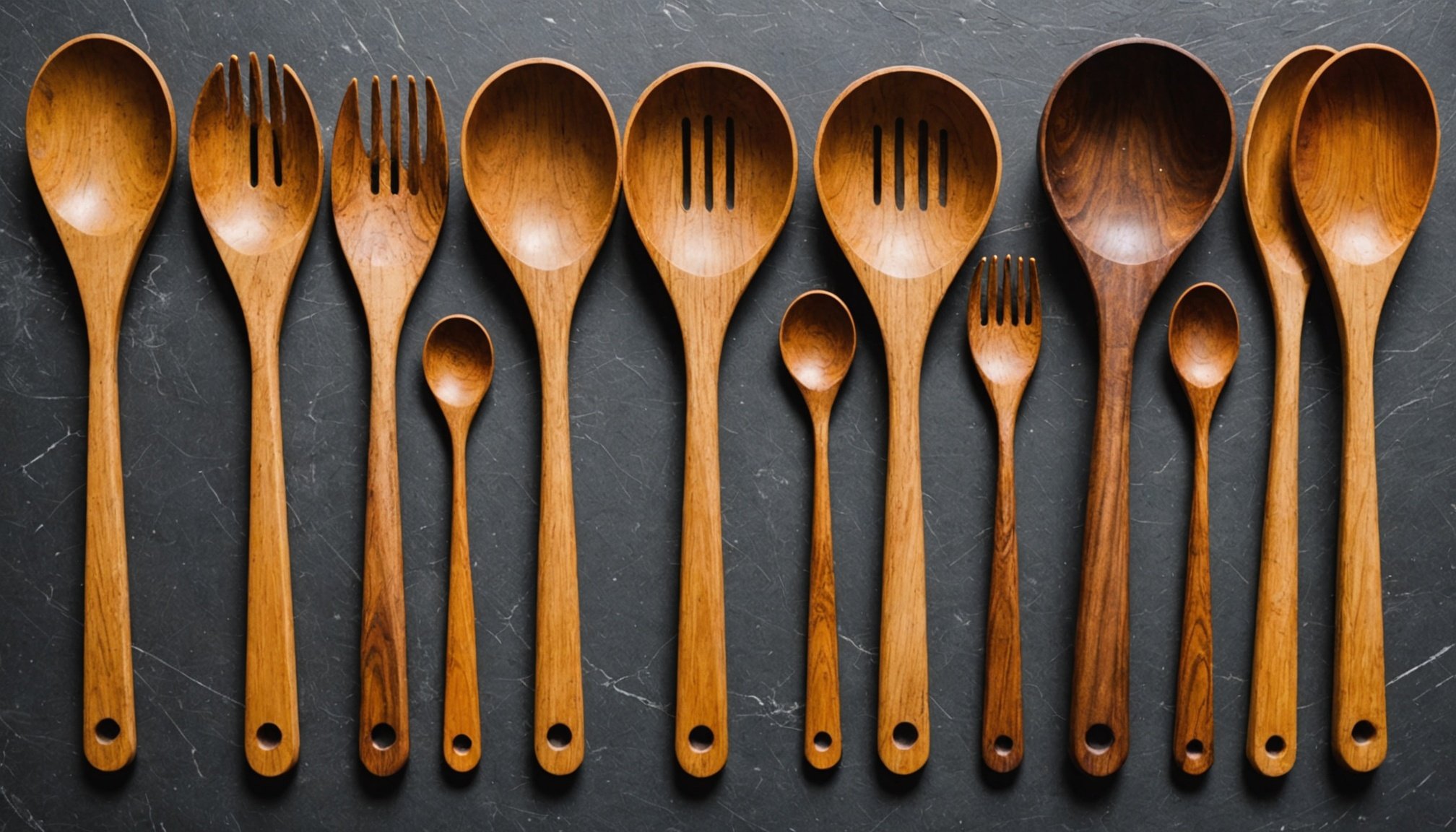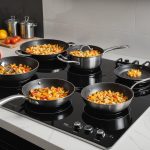Wooden kitchen utensils elevate both functionality and aesthetic appeal in your cooking space. However, without proper care, these beautiful tools can lose their charm and usefulness over time. This guide offers essential tips to ensure your wooden utensils remain in top condition. You'll learn best practices for cleaning, storing, and maintaining these cherished kitchen companions, making sure they serve you well for years to come.
Importance of Caring for Wooden Kitchen Utensils
Understanding the longevity and hygiene of wooden utensils is essential.
In the same genre : Crafting the Perfect Farm-to-Table Kitchen: Innovative Design Tips for Sustainable Living
Understanding the Benefits
Proper care for wooden utensils not only enhances their longevity but also maintains kitchen hygiene. These utensils are naturally antibacterial, but their effectiveness diminishes without regular maintenance. By routinely oiling and cleaning, you ensure they remain safe for food preparation.
Impact on Longevity
The longevity of wooden utensils is significantly influenced by how well they are cared for. Without proper attention, they can crack, warp, or even develop unpleasant odors. Consistent maintenance, such as hand washing and avoiding dishwashers, extends their lifespan, making them a sustainable choice in the kitchen.
Also to see : Discover the Benefits of Incorporating Bamboo into Your Kitchen Design: A Sustainable and Stylish Choice
Common Misconceptions
Several misconceptions exist about wooden utensil maintenance. It's often believed that they are difficult to care for or less hygienic than metal counterparts. In reality, with simple steps like using mineral oil and avoiding prolonged water exposure, these utensils can remain both durable and clean.
Benefits of Proper Care:
- Extends utensil longevity
- Enhances kitchen hygiene
- Preserves natural antibacterial properties
By understanding these aspects, you can ensure your wooden utensils continue to serve your kitchen needs effectively.
Cleaning Wooden Kitchen Utensils
Maintaining hygiene and longevity through proper cleaning practices.
Recommended Cleaning Products
Choosing the right cleaning products is crucial for maintaining the integrity of your wooden utensils. It's best to use gentle, non-abrasive products to avoid damaging the wood. Mild dish soap, warm water, and a soft sponge are ideal for regular cleaning. For deeper cleaning, consider using baking soda or a mixture of vinegar and water. These options ensure the removal of stubborn stains while preserving the utensil's natural properties.
Step-by-Step Cleaning Instructions
To clean your wooden utensils effectively, follow these steps:
- Rinse the utensil under warm water to remove food particles.
- Apply a small amount of mild dish soap to a soft sponge.
- Gently scrub the utensil, focusing on areas with stains.
- Rinse thoroughly with warm water to remove soap residue.
- Dry immediately with a clean towel to prevent moisture absorption.
Frequency of Cleaning
The frequency of cleaning your wooden utensils depends on their usage. For utensils used daily, a quick rinse after each use and a thorough cleaning once a week is recommended. If used less frequently, ensure they are cleaned before and after each use. Regular cleaning not only maintains hygiene but also extends the life of your utensils.
Drying Techniques for Wooden Utensils
Effective drying is crucial for maintaining the quality of your wooden utensils.
Best Practices for Drying
Proper drying wooden utensils is essential to prevent damage and maintain their longevity. After cleaning, immediately dry them with a clean towel. This prevents moisture from seeping into the wood, which can cause warping. Ensure utensils are stored in an upright position to allow air circulation.
Avoiding Common Drying Mistakes
Many make the mistake of leaving wooden utensils to air dry on a flat surface. This can trap moisture, leading to deterioration. Avoid placing them in direct sunlight or near heat sources, as this can cause the wood to crack or split.
The Role of Moisture in Utensil Deterioration
Moisture is a significant factor in the deterioration of wooden utensils. Excess moisture can lead to bacterial growth, warping, and unpleasant odors. Proper moisture management is vital to preserve their natural antibacterial properties and extend their lifespan.
Key Drying Tips:
- Use a clean towel for immediate drying
- Store upright for air circulation
- Avoid direct sunlight and heat sources
By following these drying techniques, you can effectively manage moisture and ensure your wooden utensils remain in excellent condition.
Oiling and Conditioning Wooden Kitchen Utensils
Ensuring longevity and functionality through proper care.
Types of Oils to Use
Choosing the right oils for wooden utensils is crucial for effective conditioning. Mineral oil is highly recommended due to its food-safe properties and ability to penetrate deeply into the wood. Other suitable options include beeswax and coconut oil, which provide a natural finish and enhance water resistance. Avoid using vegetable or olive oils as they can become rancid over time.
How to Apply Oil
Proper application of oil is essential for maintaining your utensils. Begin by ensuring the utensil is clean and dry. Apply a generous amount of mineral oil with a soft cloth, rubbing it into the wood in the direction of the grain. Allow the oil to soak in for several hours or overnight. Wipe off any excess oil with a clean cloth.
Frequency of Oiling
Regular oiling is necessary to keep your utensils in prime condition. As a rule of thumb, oiling wooden utensils every month is advisable. However, if the wood appears dry or feels rough, it's a sign they need re-oiling. Conditioning your utensils not only enhances their appearance but also extends their lifespan.
Quick Reference:
- Mineral oil for deep conditioning
- Apply oil in the direction of the grain
- Re-oil monthly or when the wood looks dry
Storing Wooden Kitchen Utensils
Optimal storage ensures longevity and hygiene.
Optimal Storage Solutions
Proper storing wooden utensils is crucial for maintaining their longevity and functionality. Consider using a utensil holder on the countertop for easy access and air circulation. Alternatively, a drawer with dividers can keep utensils organized and prevent them from knocking against each other, which could cause damage.
Impact of Storage on Longevity
The way you store wooden utensils significantly affects their lifespan. Storing them in a damp environment can lead to moisture absorption, causing warping or cracking. Ensure your storage area is dry and well-ventilated to preserve the integrity of the wood. Avoid stacking utensils to prevent unnecessary pressure and potential damage.
Tips for a Hygienic Storage Environment
Maintaining a hygienic storage environment is essential for utensil preservation. Regularly clean the storage area to prevent dust and bacteria buildup. Use a liner in drawers to protect the wood from scratches and moisture.
- Keep storage dry and ventilated
- Avoid overcrowding utensils
- Regularly clean storage areas
By adopting these storage practices, you can ensure your wooden utensils remain in excellent condition, supporting both kitchen organization and utensil preservation.
Common Mistakes to Avoid
Avoiding pitfalls ensures the longevity of your wooden utensils.
Top Care Mistakes
Improper maintenance of wooden utensils often leads to unnecessary utensil damage. Common mistakes include using harsh cleaning agents, soaking utensils in water, and neglecting regular oiling. These errors can weaken the wood, causing it to crack or warp. Always opt for gentle cleaning methods and ensure utensils are thoroughly dried to prevent moisture-related issues.
Signs of Neglect
Recognizing signs of neglect in wooden utensils is crucial for timely intervention. Look for visible cracks, a rough texture, or a dull appearance. These indicate a lack of proper care and possible utensil damage. Regularly inspect your utensils for these signs to maintain their functionality and hygiene.
How to Remedy Common Issues
Restoring neglected utensils is possible with the right approach. Begin by lightly sanding any rough or cracked areas. Follow with a thorough cleaning using mild soap and water. Apply a generous coat of mineral oil to rejuvenate the wood's appearance and texture.
- Avoid soaking in water
- Use gentle cleaning agents
- Regularly re-oil utensils
By addressing these mistakes in utensil care, you can extend the life of your kitchen tools and ensure they remain safe for use.
Expert Insights and FAQs
Enhance your knowledge with expert advice and answers to common questions.
Expert Recommendations for Wooden Utensil Care
Culinary professionals emphasize the importance of consistent care for maintaining wooden utensils. They recommend using mineral oil regularly to preserve the wood's natural properties. Experts also suggest avoiding dishwashers due to the risk of warping and cracking. Instead, hand wash with mild soap and warm water.
Frequently Asked Questions
Q: How often should I oil my wooden utensils?
A: Oiling is recommended monthly or whenever the wood appears dry. This keeps the utensils in optimal condition.
Q: Can I use olive oil for conditioning?
A: It's best to avoid olive oil as it can turn rancid. Opt for mineral oil or beeswax for safe conditioning.
Insightful Tips from Culinary Professionals
- Avoid soaking utensils to prevent moisture damage.
- Inspect regularly for signs of wear and recondition as needed.
- Use a soft sponge for cleaning to maintain the wood's surface.
By following these expert insights, you ensure your wooden utensils remain durable and hygienic, supporting their longevity and functionality in the kitchen. This practical advice empowers you to make informed decisions about utensil care.













